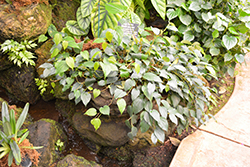It's all about ...
plants

Height: 13 feet
Spread: 10 feet
Sunlight:
![]()
Hardiness Zone: 9b
Description:
This climbing variety showcases long vigorous vines with shiny dark green, almond shaped leaves; producing long cylindrical clusters of small fruit, emerging green and then dried to black; wonderful in containers or hanging baskets; requires trellising
Edible Qualities
Black Peppercorn is a perennial that is commonly grown for its edible qualities. It produces clusters of green round berries which are usually ready for picking from early summer to early fall. The berries will often fade to black over time. The berries have a sharp taste with a hard texture and a distinctive fragrance.
The berries are most often used in the following ways:
- Eating When Cooked/Prepared
- Drying
- Pickling
- Seasoning
Features & Attributes
Black Peppercorn's large glossy pointy leaves remain dark green in colour throughout the year on a plant with a spreading habit of growth. It produces green berries from early summer to early fall, which fade to black over time.
This is an herbaceous evergreen perennial vine with a spreading, ground-hugging habit of growth. Its relatively coarse texture can be used to stand it apart from other garden plants with finer foliage. This plant will require occasional maintenance and upkeep, and is best cleaned up in early spring before it resumes active growth for the season. Gardeners should be aware of the following characteristic(s) that may warrant special consideration;
- Spreading
Aside from its primary use as an edible, Black Peppercorn is sutiable for the following landscape applications;
- Hedges/Screening
- General Garden Use
- Container Planting
- Hanging Baskets
Planting & Growing
Black Peppercorn will grow to be about 13 feet tall at maturity, with a spread of 10 feet. As a climbing vine, it should be planted next to a fence, trellis or other rigid structure where it can be trained to grow upwards on it. The stalks can be weak and so it may require staking in exposed sites or excessively rich soils. It grows at a medium rate, and under ideal conditions can be expected to live for approximately 10 years. As an evegreen perennial, this plant will typically keep its form and foliage year-round.
This plant is typically grown in a designated edibles garden. It should be grown in a location with partial shade or which is shaded from the hot afternoon sun. It requires an evenly moist well-drained soil for optimal growth. It is not particular as to soil type or pH. It is somewhat tolerant of urban pollution. Consider applying a thick mulch around the root zone over the growing season to conserve soil moisture. This species is not originally from North America. It can be propagated by division.
Black Peppercorn is a good choice for the edible garden, but it is also well-suited for use in outdoor containers and hanging baskets. Because of its spreading habit of growth, it is ideally suited for use as a 'spiller' in the 'spiller-thriller-filler' container combination; plant it near the edges where it can spill gracefully over the pot. It is even sizeable enough that it can be grown alone in a suitable container. Note that when growing plants in outdoor containers and baskets, they may require more frequent waterings than they would in the yard or garden. Be aware that in our climate, most plants cannot be expected to survive the winter if left in containers outdoors, and this plant is no exception. Contact our experts for more information on how to protect it over the winter months.
This plant is not reliably hardy in our region, and certain restrictions may apply; contact the store for more information.
